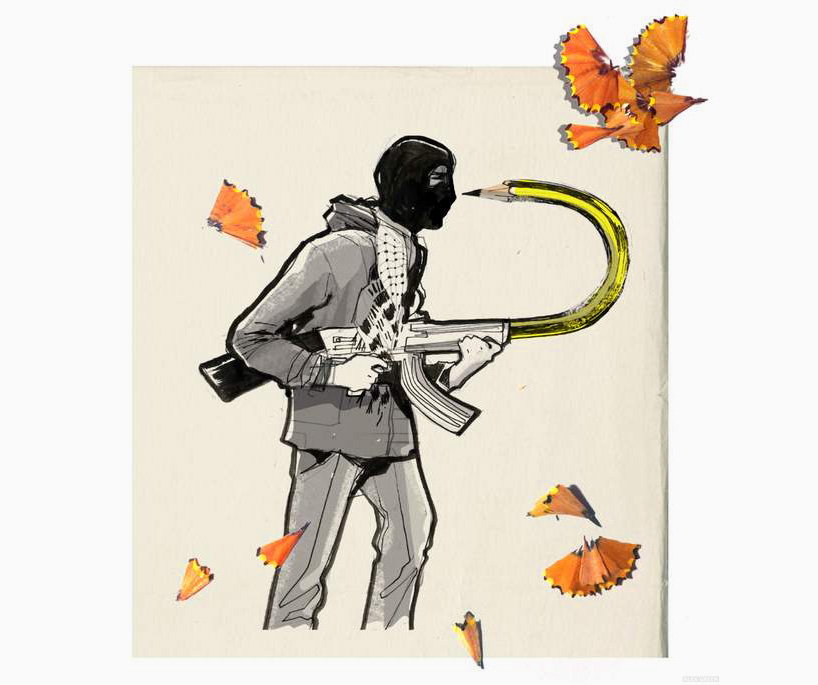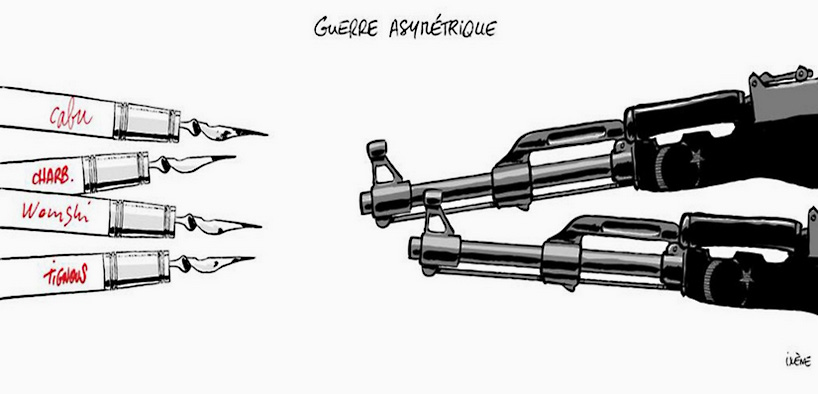The War of Art: Je Suis Charlie!
/That art is still capable of provoking political unrest, violent debate, and protest is an attestation of its value and power. It is also an admission of its complexity; inextricably linked to notions of liberty, truth and justice, art seems set to continue to attract the attention of those who would prefer it to be silenced. —The Art Media Agency
Twelve people on Wednesday were shot to death in the offices of Charlie Hebdo, a satirical and controversial newspaper in Paris that features cartoons, articles and jokes. The attack is thought to be in backlash to cartoons considered offensive to Islam. Among the dead were Stéphane "Charb" Charbonnier, the newspaper's editor and head cartoonist. The day after the attack, remaining staff members at the paper announced that publication would continue, with next Wednesday's issue spiking in production by more than 30 times its normal run to bring up to 3 million copies to the public.
Charlie Hebdo (French for "Weekly Charlie") regularly takes aim at racism, the far right, religion, and other divisive political and cultural issues. It was first published in 1969. The paper closed in 1981, but was revived in 1992.
Charlie Hebdo was hit in 2011 by firebombs in another terrorist attack performed as backlash to an issue that came out purporting to be guest-edited by Muhammad. The staff at Charlie Hebdo refused to censor themselves after the last attack; and when this week's gunmen arrived at the magazine's office, the suspects called for the offending cartoonists by name.
The two suspects, brothers Cherif and Said Kouachi, were killed today after a seven-hour hostage siege, according toNBC.
The attacks bring to mind the provocative power of art: to entertain, to enlighten, and most importantly, to make people think. Sometimes the act is offensive. Sometimes it's funny. Sometimes it's jarring; just enough to knock you off your feet and make you consider the world differently. Check out this poignant take on the Charlie Hebdo attacks by graphic artist and journalist Joe Sacco:
Without a doubt, some art is done in poor taste. And we may not agree with everything a piece of art has to say. But the function of art to shine a spotlight on abuses, civil unrest, politics, or any other component of the human condition is its vital responsibility.
French satirist, philosopher, poet and historian Voltaire (real name François-Marie Arouet) was a man whose views and work often landed him in hot water. He was forced to leave France several times for extended periods, but he refused to allow backlash against him to be a silencer. His ongoing pushes for freedom of speech and the expression of all ideas caused him to be credited with the famous line:
"I disapprove of what you say, but I will defend to the death your right to say it."
Image from Ironic Surrealism.
Calls for censorship over art are nothing new; nor are violent acts waged against people we consider offensive or with whom we disagree. It's hard to say or do just about anything without getting somebody's panties in a bunch. And when you try to open up a dialogue about something as polarizing as race, gender, sex, religion or politics, you've compounding an already tricky situation.
But what happened at the offices of Charlie Hebdo is heartbreaking. We forget in this day and age that hate crimes continue to occur; as most of us are blessed enough to be shielded from these atrocities. That people would feel so insecure and desperate in their own faith and positioning in this world that they would justify violence against perpetrators of humor and art is frustrating, humiliating, embarrassing, and utterly sad.
Caricature as a Western discipline goes back to Leonardo da Vinci's artistic explorations of "the ideal type of deformity"—the grotesque—which he used to better understand the concept of ideal beauty. Cartoons since then have worked tirelessly as a medium for commentary that presented real-world issues in a funny (thereby more digestable) manner while angling to sway viewer's opinions.
We look to the past at stories of Michelangelo's works being thought of as obscene, or how nude paintings were considered pornography and incited outrage. Entire bodies of work have been destroyed or defaced for being offensive. Yet censorship rears its ugly head even today, and all over the world.
Chinese artist and activist Ai Weiwei was in April 2011 held in prison for three months for deviance and plagiarism for his work "草泥马挡中央 – grass mud horse covering the middle". The piece showed Weiwei jumping naked through the air. The caption, which sounds like nonsense babble in English, sounds quite different in Chinese. The words sound almost exactly like ""肏你妈党中央"—that's “Fuck your mother, the Communist party central committee.”
"No one murdered because of this image," from The Onion, 2012.
Iran put a price on the head of British author Salman Rushdie almost 26 years ago for his portrayal of the Muhammad in The Satanic Verses. Terrorism threats abounded in 2002 at the basilica of San Petronio in Italy over a 15th-century fresco depicting Muhammad in hell.
The attack at Charlie Hebdo offices “is not in a vacuum,” said Farah Pandith, adjunct senior fellow at the Council on Foreign Relations and the U.S.’s first Special Representative to Muslim Communities, told the Wall Street Journal. “This kind of thing has been happening a long time.”
Extremists understand “that to call on freedom of expression—something that they don’t like—is a great tool to be able to build emotion,” Ms. Pandith said. “Imagery, music, art: these are all deeply personal expressions that people absorb.”
Check out some of these cartoons in response to the Charlie Hebdo shooting, followed up by my good buddy Dave Knapp and his friend Jeremy Taylor's song, Live Standing Up!
Cartoon byDavid Pope.


image by illustrator and graphic designer lucille clerc / image via twitter
Update: Here's the cover image on the newest issue of Charlie Hebdo. In it, you see Muhammad with a tear on his face holding a sign "Je sis Charlie", or "I am Charlie", with words emblazoned overhead: All is Forgiven. Asked to explain the magazine’s front cover, surviving columnist Zineb El Rhazoui said: “We feel that we have to forgive what happened. I think those who have been killed, if they would have been able to have a coffee today with the terrorists and just talk to ask them why have they done this … We feel at the Charlie Hebdo team that we need to forgive.”

































